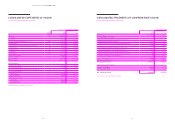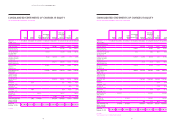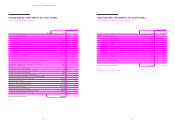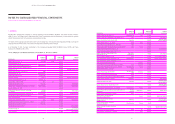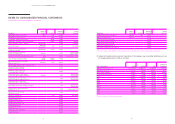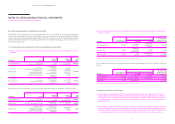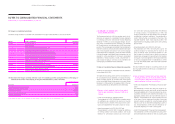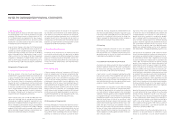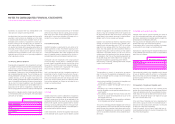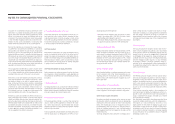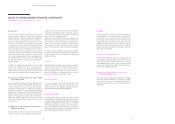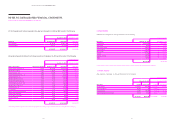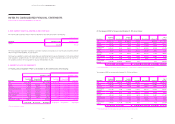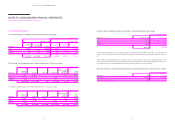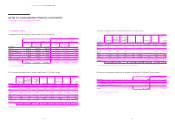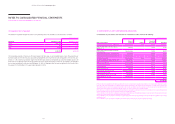Hyundai 2015 Annual Report Download - page 53
Download and view the complete annual report
Please find page 53 of the 2015 Hyundai annual report below. You can navigate through the pages in the report by either clicking on the pages listed below, or by using the keyword search tool below to find specific information within the annual report.
HYUNDAI MOTOR COMPANY Annual Report 2015
104 105
4) AFS financial assets
AFS financial assets are those non-derivative financial assets
that are designated as AFS or are not classified as loans and
receivables, HTM financial assets nor financial assets at FVT-
PL. AFS financial assets are measured at fair value. However,
investments in equity instruments that do not have a quoted
market price in an active market and whose fair value cannot
be reliably measured are measured at cost.
A gain or loss on changes in fair value of AFS financial assets
is recognized in other comprehensive income, except for im-
pairment loss, interest calculated using the effective interest
method and foreign exchange gains and losses on monetary
assets. Accumulated other comprehensive income is reclas-
sified to profit or loss from equity at the time of impairment
recognition or elimination of related financial assets. Divi-
dends on an AFS equity instrument are recognized in profit or
loss when the Group’s right to receive payment is established.
(8) Impairment of financial assets
1) Financial assets carried at amortized cost
The Group assesses at the end of each reporting period
whether there is any objective evidence that a financial asset
or group of financial assets is impaired. If any such evidence
exists, the Group determines the amount of any impairment
loss. The amount of the loss is measured as the difference
between the asset’s carrying amount and the present value
of estimated future cash flows, excluding future credit loss-
es that have not been incurred, discounted at the financial
asset’s original effective interest rate computed at initial
recognition. The carrying amount of the asset is reduced ei-
ther directly or through use of an allowance account and the
amount of the loss is recognized in profit or loss.
Certain financial assets such as trade receivables and finan-
cial services receivables that are assessed not to be impaired
individually are, in addition, assessed for impairment on a col-
lective basis. The objective evidence of impairment for a port-
folio of receivables could include the Group’s past experience
of collecting payments, an increase in the number of delayed
payments in the portfolio past the average credit period, as
well as observable changes in national or local economic con-
ditions that correlate with default on receivables.
If, in a subsequent period, the amount of the impairment
loss decreases and the decrease can be related objectively
to an event occurring after the impairment was recognized,
the previously recognized impairment loss is reversed and
recognized in profit or loss. The reversal shall not result in a
carrying amount of the financial asset that exceeds what the
amortized cost would have been had the impairment not been
recognized at the date the impairment is reversed.
2) Financial assets carried at cost
The amount of the impairment loss on financial assets that
are carried at cost because their fair value cannot be reliably
measured is measured as the difference between the carrying
amount of the financial asset and the present value of esti-
mated future cash flows discounted at the current market rate
of return for a similar financial asset. Such impairment losses
are not reversed.
3) AFS financial assets
If there is objective evidence of impairment on AFS financial
assets, the cumulative loss that has been recognized in other
comprehensive income less any impairment loss previously
recognized in profit or loss is reclassified from equity to profit
or loss. In the case of equity instruments, objective evidence
of impairment is taken to exist if there is a significant or pro-
longed decline in the fair value of each investment below its
cost. Impairment losses recognized in profit or loss for invest-
ments in equity instruments classified as AFS are not reversed
through profit or loss. Meanwhile, if, in a subsequent period,
the fair value of a debt instrument classified as AFS increases
and the increase can be objectively related to an event occur-
ring after the impairment loss was recognized in profit or loss,
the impairment loss is reversed through profit or loss.
(9) Derecognition of financial assets
The Group derecognizes a financial asset when the contrac-
tual rights to the cash flows from the asset expire, or when it
transfers the financial asset and substantially all the risks and
rewards of ownership of the asset to another entity. If the
Group neither retains substantially all the risks and rewards of
ownership nor transfers and continues to control the trans-
ferred asset, the Group recognizes its retained interest in the
asset and associated liability for amounts it may have to pay.
If the Group retains substantially all the risks and rewards of
ownership of a transferred financial asset, the Group con-
tinues to recognize the financial asset and also recognizes a
collateralized borrowing for the proceeds received.
(10) Inventory
Inventory is measured at the lower of cost or net realizable
value. Inventory cost including the fixed and variable manu-
facturing overhead cost, is calculated, using the moving aver-
age method except for the cost for inventory in transit which
is determined by the identified cost method.
(11) Investments in associates and joint ventures
An associate is an entity over which the Group has significant
influence. Significant influence is the power to participate in
the financial and operating policy decisions of the investee
but is not control or joint control over those policies.
A joint venture is a joint arrangement whereby the parties
that have joint control of the arrangement have rights to the
net assets of the joint arrangement. Joint control is the con-
tractually agreed sharing of control of an arrangement, which
exists only when decisions about the relevant activities require
unanimous consent of the parties sharing control.
The investment in an associate or a joint venture is initially
recognized at cost and accounted for using the equity meth-
od. Under the equity method, an investment in an associate
or a joint venture is initially recognized in the consolidated
statement of financial position at cost and adjusted thereafter
to recognize the Group’s share of the profit or loss and other
comprehensive income of the associate or the joint venture.
When the Group’s share of losses of an associate or a joint
venture exceeds the Group’s interest in that associate or joint
venture (which includes any long-term interests that, in sub-
stance, form part of the Group’s net investment in the asso-
ciate or the joint venture), the Group discontinues recognizing
its share of further losses. Additional losses are recognized
only to the extent that the Group has incurred legal or con-
structive obligations or made payments on behalf of the asso-
ciate or the joint venture.
Any excess of the cost of acquisition over the Group’s share
of the net fair value of the identifiable assets, liabilities and
contingent liabilities of an associate or a joint venture rec-
ognized at the date of acquisition is recognized as goodwill,
which is included within the carrying amount of the invest-
ment. The entire carrying amount of the investment including
goodwill is tested for impairment and presented at the amount
less accumulated impairment losses. Any excess of the
Group’s share of the net fair value of the identifiable assets,
liabilities and contingent liabilities over the cost of acquisition,
after reassessment, is recognized immediately in profit or loss.
Upon disposal of an associate or a joint venture that results
in the Group losing significant influence over that associate or
joint venture, any retained investment is measured at fair val-
ue at that date and the fair value is regarded as its fair value
on initial recognition as a financial asset in accordance with
K-IFRS 1039. The difference between the previous carrying
amount of the associate or joint venture attributable to the
retained interest and its fair value is included in the determi-
nation of the gain or loss on disposal of the associate or joint
venture. In addition, the Group accounts for all amounts pre-
viously recognized in other comprehensive income in relation
to that associate or joint venture on the same basis we would
be required if that associate or joint venture had directly dis-
posed of the related assets or liabilities. Therefore, if a gain
or loss previously recognized in other comprehensive income
by that associate or joint venture would be reclassified to
profit or loss on the disposal of the related assets or liabilities,
the Group reclassifies the gain or loss from equity to profit or
loss (as reclassification adjustment) when it loses significant
influence over that associate or joint venture.
When the Group reduces its ownership interest in an associate
or a joint venture but the Group continues to use the equity
method, the Group reclassifies to profit or loss the propor-
tion of the gain or loss that had previously been recognized
in other comprehensive income relating to that reduction in
ownership interest if that gain or loss would be reclassified to
profit or loss on the disposal of the related assets or liabili-
ties. In addition, the Group applies K-IFRS 1105 to a portion of
investment in an associate or a joint venture that meets the
criteria to be classified as held for sale.
The Group continues to use the equity method when an in-
vestment in an associate becomes an investment in a joint
venture or an investment in a joint venture becomes an
NOTES TO CONSOLIDATED FINANCIAL STATEMENTS
AS OF AND FOR THE YEARS ENDED DECEMBER 31, 2015 AND 2014


